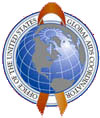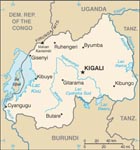|

Office of the United States Global AIDS Coordinator
Providing leadership, coordination and oversight to the unified U.S. Government effort to implement the President?s Emergency Plan for AIDS Relief
U.S. Department of State
U.S. Agency for International Development
U.S. Department of Defense
U.S. Department of Commerce
U.S. Department of Labor
U.S, Department of Health and Human
Services
Peace Corps
Mailing address:
SA-29, 2nd Floor
2201 C Street, NW Washington, DC 20522-2920
www.state.gov/s/gac
1. UNAIDS, Report of the Global AIDS Epidemic, 2004. |
 HIV/AIDS Situation in Rwanda HIV/AIDS Situation in Rwanda
HIV Infected: 250,0001
AIDS Deaths: 22,0001
AIDS Orphans: 160,0001
According to the United Nations Joint Programme on HIV/ AIDS (UNAIDS), of the roughly 250,0001 persons infected with HIV/AIDS, 22,0001 are children under the age of 16. Rwanda has a generalized epidemic with all sites reporting greater than 1 percent prevalence, but the epidemic is not equally distributed throughout the urban and rural areas of the country. While there is a high use of prenatal services (92 percent of pregnant women attend at least one prenatal visit in Rwanda), home delivery remains the norm (only 26 percent of Rwandans deliver in a health care facility). These patterns of service have important implications for the design and execution of prevention of mother-to-child-HIV transmission (PMTCT) interventions.
U.S. Government Response
The Government of Rwanda (GOR) has a national HIV/AIDS action framework in place and a national monitoring and evaluation plan developed collaboratively by GOR, the U.S. Government (USG) and other major donors. The USG works with the GOR to coordinate resources in support of the Rwanda National HIV/AIDS Strategic Plan (2002-2006), the HIV/ AIDS Treatment and Care Plan (2003-2007) and the National Prevention Plan. The USG also provides management and technical assistance to institutions in the Office of the Minister of State for HIV/AIDS and the Ministry of Health (MOH). |
| Challenges to Emergency Plan Implementation
Rwanda is among the world?s least developed countries, ranking 159 of 177 in the United Nations Development Programme?s 2004 Human Development Index. Some 60 percent of the population lives in poverty. During the three months of genocide in 1994, mass rape, sexual torture and psychological trauma were common. Massive population flows following the genocide resulted in new urban and rural settlement patterns and uncertainty regarding HIV prevalence rates. The shortage of human resources throughout the health sector is a significant constraint. Of Rwandans killed or displaced during the genocide, a disproportionate number were highly skilled and educated members of society, including doctors, nurses and other health workers. Due to widespread poverty, many health centers lack essential physical facilities, equipment and supplies. Basic infrastructure weaknesses constrain the implementation of networks. For example, patient transport systems are underdeveloped, phone and electronic connection of facilities is minimal, and basic operation of sites is severely under funded. Social stigma associated with HIV is widespread and may remain a disincentive to HIV testing and disclosure.
Emergency Plan Results
Number of individuals reached with community outreach HIV/AIDS prevention programs that promote abstinence and being faithful: 9,400
Number of pregnant women receiving prevention of mother to child HIV transmission ( PMTCT) services: 49,300
Number of pregnant women receiving antiretroviral prophylaxis: 2,800
Number of individuals receiving counseling and testing: 104,000
Number of HIV-infected individuals who received palliative care/basic health care and support: 15,700
Number of orphans and vulnerable children (OVCs) who were served by an OVC program: 260
Number of individuals receiving upstream system strengthening support for treatment:1 200
Number of individuals receiving downstream site-specific support for treatment:2 10,100
Prevention and care results reflect accomplishments through September 2004 and combine upstream and downstream support. Treatment results reflect accomplishments through March 2005.
1. Number of individuals reached through upstream systems strengthening includes those supported through contributions to support national strategies through national, regional, and local activities such as training, laboratory support, monitoring and evaluation, logistics
and distribution systems, protocol and curriculum development.
2. Number of individuals reached through downstream site-specific support includes those receiving treatment where the Emergency Plan supports programs at the point of service delivery. |
The U.S. President?s Emergency Plan for AIDS Relief (the Emergency Plan) response in Rwanda includes:
- Building human capacity;
- Engaging new partners;
- Supporting mass media and church-based campaigns addressing HIV risk;
- Integrating HIV prevention activities with community-based care programs;
- Assisting the national drug procurement entity to improve procurement procedures, storage and distribution, quality assurance/quality control systems, physical infrastructure and information systems; and,
- Supporting the National Tuberculosis (TB) Program (PNILT) to integrate TB and HIV services at health facilities throughout Rwanda.
Recognizing the global HIV/AIDS pandemic as one of the greatest health challenges of our time, President George W. Bush announced the Emergency Plan in 2003?the largest international health initiative in history by one nation to address a single disease. Under the leadership of the U.S. Global AIDS Coordinator, USG agencies implement the Emergency Plan, working collaboratively as integrated, interagency country teams under the direction of the U.S. Ambassador. These teams capitalize on the expertise of each USG agency and leverage partnerships with host governments, multilateral institutions, nongovernmental organizations (NGOs) and the private sector to implement effective programs for combating HIV/AIDS and ensure efficient use of USG resources.
Rwanda is one of 15 focus countries of the Emergency Plan which collectively represent at least 50 percent of HIV infections worldwide. Under the Emergency Plan, Rwanda received $39.3 million in FY2004 to support a comprehensive HIV/AIDS prevention, treatment and care program. In FY2005, the U.S. is committing approximately $56.4 million to support Rwanda?s efforts to combat HIV/AIDS.
Emergency Plan Achievements in Rwanda
Critical Interventions for HIV/AIDS Prevention
- USG efforts have assisted the MOH to establish and support PMTCT services at 10 hospitals and health centers.
- With PMTCT services available, testing of partners increased from 10 percent in December 2002 to 88 percent in September 2004.
- PMTCT sites expanded services to counsel 99 percent of the 12,379 women attending prenatal care.
- 95 percent of women counseled accepted testing.
- Quality assurance teams at 18 participating health centers and hospitals help address problems of retention, low return rates, and poor quality PMTCT service delivery. The teams use a collaborative approach to analyze procedures, identify best practices and share them with other participating sites. This has resulted, at some participating sites, in 100 percent of women tested returning for their results and a 30 percent increase in the number of women receiving nevirapine.
Critical Interventions for HIV/AIDS Care
- USG support provides a comprehensive package of care and support to over 9,000 people living with HIV/AIDS (PLWHA) in associations and other non-associated PLWA through partnerships with health facilities.
- Work to reduce stigma and discrimination has resulted in a rise in the number of associations from 30 to 299 in seven provinces.
- Leveraging USG support, one partner provided 3,323 PLWHA with food assistance from other partners; 2,842 PLWHA received seeds and materials for home gardens; and 3,535 PLWA received goats that provide milk and fertilizer for agricultural plots.
- To reduce community isolation and discrimination, the USG supported training for community volunteers to provide homebased care for PLWHA.
Critical Interventions for HIV/AIDS Treatment
- Antiretroviral (ARV) services have been rapidly scaled up with support from the Emergency Plan and other donors, including the World Bank MAP and the Global Fund to Fight AIDS, Malaria and Tuberculosis. As of March 31, 2005, 46 sites ? both hospitals and health centers ?provided ART to more than 10,000 PLWHA.
- With USG assistance the GOR developed and implemented a standardized national approach to HIV/AIDS treatment. Antiretroviral treatment (ART) service providers throughout the country attend a uniform classroom training conducted by the Treatment and Research AIDS Center (TRAC), and ART reporting and client forms are standardized across all sites.
- Site-level reporting on national program indicators and ARV drug shortages or stock-outs is completed via a national phone- and Internet-based reporting system, "TRACNET. "
- ARV drug procurements are coordinated through a national mechanism to which the USG contributes second-line and modified first-line drugs and other donors contribute generic first-line drugs.
- The USG continues to strengthen capacity at key national institutions such as TRAC and the National Reference Laboratory through a combination of technical assistance, infrastructure support, and financial support.
|



